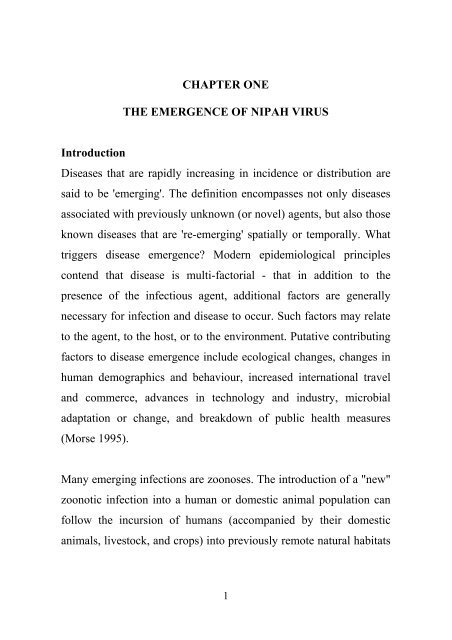manual on the diagnosis of nipah virus infection in animals
manual on the diagnosis of nipah virus infection in animals
manual on the diagnosis of nipah virus infection in animals
- No tags were found...
Create successful ePaper yourself
Turn your PDF publications into a flip-book with our unique Google optimized e-Paper software.
CHAPTER ONETHE EMERGENCE OF NIPAH VIRUSIntroducti<strong>on</strong>Diseases that are rapidly <strong>in</strong>creas<strong>in</strong>g <strong>in</strong> <strong>in</strong>cidence or distributi<strong>on</strong> aresaid to be 'emerg<strong>in</strong>g'. The def<strong>in</strong>iti<strong>on</strong> encompasses not <strong>on</strong>ly diseasesassociated with previously unknown (or novel) agents, but also thoseknown diseases that are 're-emerg<strong>in</strong>g' spatially or temporally. Whattriggers disease emergence? Modern epidemiological pr<strong>in</strong>ciplesc<strong>on</strong>tend that disease is multi-factorial - that <strong>in</strong> additi<strong>on</strong> to <strong>the</strong>presence <strong>of</strong> <strong>the</strong> <strong>in</strong>fectious agent, additi<strong>on</strong>al factors are generallynecessary for <strong>in</strong>fecti<strong>on</strong> and disease to occur. Such factors may relateto <strong>the</strong> agent, to <strong>the</strong> host, or to <strong>the</strong> envir<strong>on</strong>ment. Putative c<strong>on</strong>tribut<strong>in</strong>gfactors to disease emergence <strong>in</strong>clude ecological changes, changes <strong>in</strong>human demographics and behaviour, <strong>in</strong>creased <strong>in</strong>ternati<strong>on</strong>al traveland commerce, advances <strong>in</strong> technology and <strong>in</strong>dustry, microbialadaptati<strong>on</strong> or change, and breakdown <strong>of</strong> public health measures(Morse 1995).Many emerg<strong>in</strong>g <strong>in</strong>fecti<strong>on</strong>s are zo<strong>on</strong>oses. The <strong>in</strong>troducti<strong>on</strong> <strong>of</strong> a "new"zo<strong>on</strong>otic <strong>in</strong>fecti<strong>on</strong> <strong>in</strong>to a human or domestic animal populati<strong>on</strong> canfollow <strong>the</strong> <strong>in</strong>cursi<strong>on</strong> <strong>of</strong> humans (accompanied by <strong>the</strong>ir domestic<strong>animals</strong>, livestock, and crops) <strong>in</strong>to previously remote natural habitats1
















